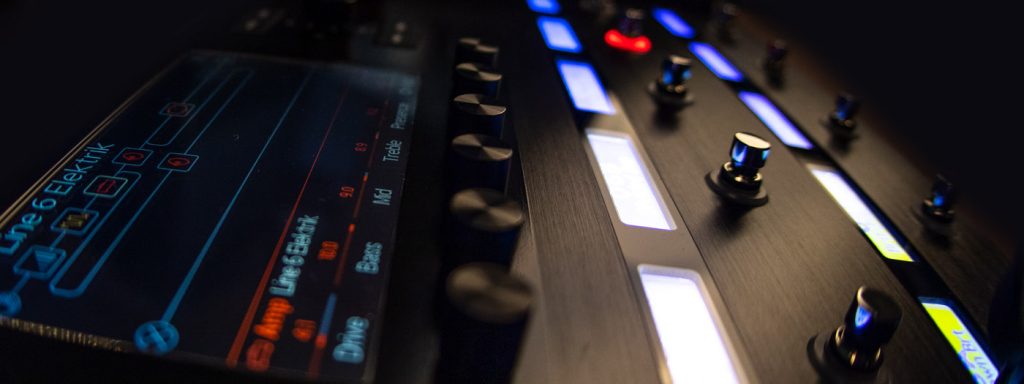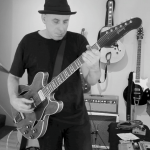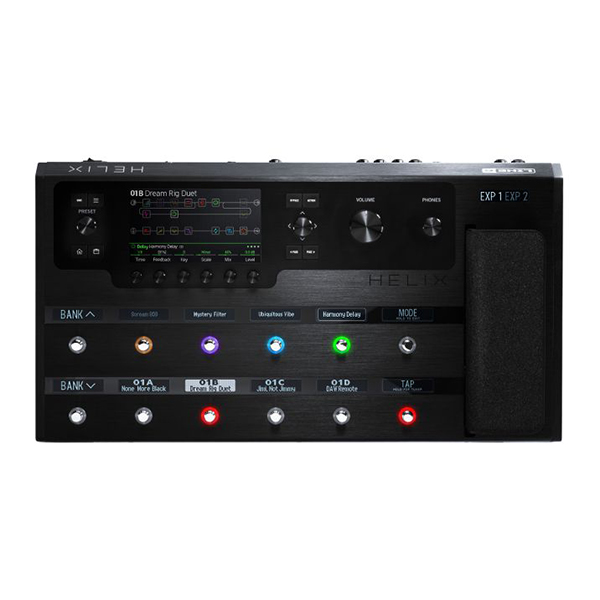The Man Behind the Modelers – Eric Klein Talks Helix 3.0 with Joe Gore
by Joe Gore
As the Line 6 Chief Product Design Architect, Eric Klein is the ultimate Helix authority. Klein recently celebrated his 10th anniversary with the company.
A South Dakota native, Eric entered the industry selling musical instruments, but his dream was to design them. After stints at Tucson’s Rainbow Guitars and Roland’s Southern California headquarters, he pitched a proposal for a new product line to Line 6 founder Marcus Ryle. The idea didn’t fly, but Ryle recognized talent when he saw it. “You should work here,” he said.
Eric is affable and upbeat, a high-energy guy who seems to love talking shop. We chatted shortly before the release of Helix’s massive 3.0 upgrade. He shared some of his favorite new features and drew back the curtain on his team’s development process.
So you’re responsible for the direction of the Helix platform.
I’m one of several, I suppose. Team Helix has a bit more leeway over our direction because the line has been successful, which is great. That’s our entire impetus: Make successful products so the organization gives us the freedom to take bigger risks next time.
You’ve said that many product decisions are based on user feedback.
Oh, definitely. Working in an environment like this, you learn not to take feedback personally. Instead, you see it as an opportunity to make things better and more fun. That’s a big reason we use this online portal called IdeaScale, where users can suggest features, complain, and talk amongst themselves. They vote ideas up and down, and sometimes the debates get heated. We opened that up in 2012, and the POD HD500 customers gave us a massive list of possible improvements. So really, Helix was created from over 160 user suggestions via IdeaScale. A lot of update ideas came from there as well.
But sometimes interpreting those requests isn’t just a matter of ticking off a box. Four or five seemingly disparate user requests might ultimately point to a single solution. Sometimes you can solve multiple problems organically and simply. Requests are often about a feature from a rival product, with users asking if we can do that too. But instead of just copying that feature, we dig in to figure out where the real point of friction lies. We ask ourselves if there’s a way to solve that problem—or multiple problems—in a better, faster, and more elegant way.
“There’s no reason we should only create things that you can replace with a pedal. We should do things for which there are no pedals.”
Can you give an example?
Sure—snapshots. That feature addressed four or five user requests. Some wanted the ability to assign the same effect or amp to multiple footswitches. Others wanted seamless spillover between patches. We went back and forth for a long time figuring out how to bring snapshots front and center so the feature wasn’t hidden, but still didn’t get in the way for people who weren’t ready to use it. We were already storing the bypass state for each block with snapshots, but parameter assignment was tricky. Do you make every parameter automatically update with every snapshot, or do you add a global setting to turn it on and off? Marcus and I were discussing it one day, and he said “What if you… push-turn?” and the clouds parted. So if you push and turn a parameter’s knob, it becomes snapshot-controllable. Now everything is right there on your home screen, so you’re not digging through menus.

Are there similar examples in 3.0?
Favorites probably fit that description. Some users have asked for per-block presets, which to us feels like an unnecessary extra layer of obfuscation and distraction. Others have complained about having to keep a preset with their custom-tweaked blocks, from which to copy and paste into the preset they’re working on. Some just want to remove items they never use from the model list. So in 3.0, everyone can dial in their favorite amp or effect and save it as a favorite, and these appear at the top of the model list. You can rename them or reorder them. They even remember footswitch assignments. So if you start with an empty preset, you just go to the first empty block and spin the dial, and all your favorites are right there, already assigned to footswitches. If you use the same blocks all the time, you may never need to open the model list again.
You’ve said that Helix 3.0 can do things that you never envisioned when you launched the platform.
At the beginning we weren’t expecting to make massive, crazy, memory-intensive blocks. We figured people would want to cram in as many blocks as possible. These are multi-effects after all! But our new R&D team from Victoria, British Columbia, had a lot of cool ideas that were beyond the scope of what you would normally include in a multi-effects device. The new Glitch Delay, Shuffling Looper, and Poly Pitch blocks take up a lot of DSP. Instead of just focusing on effects that exist in the real world, we wanted to take a step toward cool and unique things that don’t exist anywhere else. We have this massive DSP engine. There’s no reason we should only create things that you can replace with a pedal. We should do things for which there are no pedals. There are a lot of creative uses for the new 3.0 models.
For example?
I’m probably most excited about Poly Pitch. It’s not unlike DigiTech’s Whammy, Ricochet, and Drop in a single model, but with entirely different pitch algorithms. But then we asked, “Why not add modulation?” If you find that octave-up sounds sometimes gets a little harsh on the high end, you can apply variable compensation that changes the amount of EQ roll-off as the pitch goes up. It lets you do things like choose how long it takes to get to the target pitch in either seconds or beats, with user-defined curves, and you can assign the effect to a momentary switch for dive bombs or tape-stop and record-scratch effects.
What about the new Glitch Delay?
Glitch Delay and the Shuffling Looper aren’t so much effects as they are musical instruments. Once you’ve captured audio, you can play the Helix knobs almost like a synth. You can choose the likelihood of a delay repeat or looper slice flipping backward or shifting by an octave. If you find something you like, you can lock it in place. They aren’t just interesting effects—they can generate cool new song ideas.

What other new blocks are you most excited about?
The Infinite Sustain block is cool. It can freeze to a specific pitch relative to what you’re playing, and you can blend that in with an expression pedal. You can play something, hold the switch, and then use an expression pedal to blend in a drone that’s, say, an octave below what you’re playing. But the processed audio isn’t static, and you don’t get that zippering sound unless you want it. We also opened up parameters that may be too granular on a dedicated pedal. It can get grainy and glitchy and weird. We wanted to add just enough extra control so people could misuse or abuse the effects.
Obviously, many users want models of their favorite amps and effects. But 3.0 includes effects they might not even realize are possible. It must be hard to juggle user expectations and user surprises.
You absolutely have to find that balance. With 3.0 we knew some effects required quite a bit of explanation: “Here are all the parameters, here’s how they work, here are some tips and tricks.” We feel fortunate that our customer base is loyal and vocal, and they help each other out. And since many of the new 3.0 effects are all over the map, I’m sure we’ll be seeing YouTube videos that make us say “Whoa, we didn’t even think to use it that way!”
How do you decide which new blocks to add? Is it a popularity contest based on the forums?
IdeaScale is a big part of it. The #1 most-request amp was the Diezel VH4, so it’s in 3.0. The Fender Princeton was #2, and that’s there as well. But we don’t want to be strictly reactionary and just check off boxes. A bunch of Line 6ers are fans of Misha [Mansoor of Periphery] so we wanted the Horizon Precision Drive. Its gate is so interesting that we spun it off into a new gate model as well. Few people requested the Revv Generator because it didn’t appear in any other modelers, but tube amp and metal guitar forums were raving about it, so we said, “Let’s get that!” If we get a request to model an amp that’s really similar to an amp we’ve already modeled, there’s less incentive to go down that road.
So do you have time to create your own music?
I’ve been working forever on a 12-song album. It’s just me and a singer. It’s noisy, poppy, dark, and loud at times. Sometimes it busts into orchestral sections. As soon as I get done with my Helix work today, I’m going to try and finish a couple of mixes.
Learn more about Helix.

Joe Gore is a musician, writer, and tech geek from San Francisco. He’s recorded and performed with dozens of renowned artists and written thousands of articles about music, musicians, and music tech for major publications. He also designs analog stompboxes and sound collections for Helix.
Related posts
Leave a Reply
You must be logged in to post a comment.
By submitting your details you are giving Yamaha Guitar Group informed consent to send you a video series on the Line 6 HX Stomp. We will only send you relevant information. We will never sell your information to any third parties. You can, of course, unsubscribe at any time. View our full privacy policy






It’s just a interview. but One of Gamechangers. that’s it.
Thank you Eric, and Joe. The greatest feeling about having Helix line products is knowing that along with a great community of vocal users, you also have an innovative R&D team that pushes all kinds of boundaries. Engagement and collaboration via IdeaScale is instrumental, few companies and product managers do it the right way. Thanks again for all your great work!
Great read! I have used Line 6 products for over 10 years and love my HELIX Rack w/Floor Control 3.0. What I find wonderful, is my ability to create a unique toneprint. The IR’s, and ease of use through various signal ports keep me focused on the music.
Keep up the great work. ~D
I thank you Eric for absolute best most groundbreaking change to my ability to get that sound, and now you have made it so very easy to do so, I love it so I now have 2 Helix Rack units.
Thanks, gdimeris! It was a total pleasure putting this together. Eric is smart, passionate, and very, very cool. Impressive dude!
Just wanted to say the 3.0 upgrade is phenomenal! My HD500 died 7 day before I was to start playing with a new worship team at my church. Went out to buy the Helix…it is so well designed and intuitive to use that I was dialed in and ready to go for that first Sunday.
Thanks for an awesome product…the upgrade to 3.0 has blown me away!
Thanks guys. Eric, I have been a line 6 guy since the AX2 and original pod. The helix is so great and your team keeps making it better. As a consumer I really appreciate the company enhancing the product line and supporting their users. Adding the extra blocks to the stomp has made it perfect for my use. I can’t say thanks enough for that.
Congratulations Line 6 and Eric Klein. I remember Eric from the Roland days. Eric was always a nice guy , super talented and a class act. I’m presently using the “other modelers” but now I want a Helix. Keep it up guys 👍🎸🤘